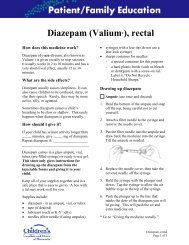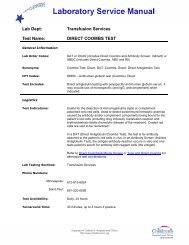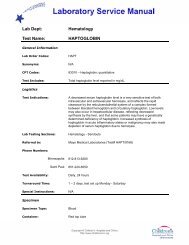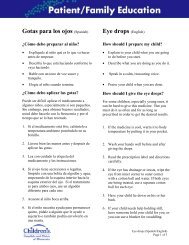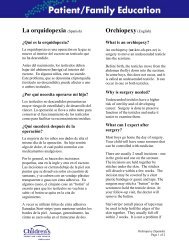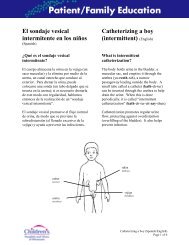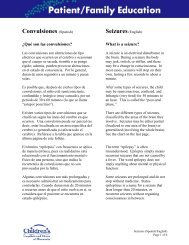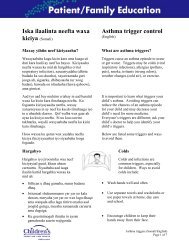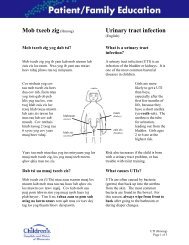Imperforate anus - Children's Hospitals and Clinics of Minnesota
Imperforate anus - Children's Hospitals and Clinics of Minnesota
Imperforate anus - Children's Hospitals and Clinics of Minnesota
You also want an ePaper? Increase the reach of your titles
YUMPU automatically turns print PDFs into web optimized ePapers that Google loves.
<strong>Imperforate</strong> <strong>anus</strong><br />
What is imperforate <strong>anus</strong>?<br />
<strong>Imperforate</strong> <strong>anus</strong> occurs when the anal<br />
opening is absent or not in a normal<br />
position. It is a birth defect caused by the<br />
failure <strong>of</strong> normal development <strong>of</strong> the anal<br />
area. Sometimes a fistula (abnormal<br />
passage) is present between the bowel <strong>and</strong><br />
the vagina in girls, or between the bowel <strong>and</strong><br />
the urinary tract in boys.<br />
There are three types <strong>of</strong> imperforate <strong>anus</strong>:<br />
High type - no anal opening is present <strong>and</strong><br />
the rectum ends above the muscles at the<br />
bottom <strong>of</strong> the pelvis (hip bones). These<br />
children may have a fistula.<br />
Intermediate type – the end <strong>of</strong> the rectum<br />
<strong>and</strong> anal canal extend through the muscle at<br />
the bottom <strong>of</strong> the pelvis. These children may<br />
have a fistula.<br />
Low type - the rectum ends below the<br />
muscles at the bottom <strong>of</strong> the pelvis. There is<br />
<strong>of</strong>ten an anal opening present, but it is in an<br />
abnormal position or is covered by a<br />
membrane.<br />
What causes an imperforate <strong>anus</strong>?<br />
There is no known cause for the condition,<br />
which occurs in 1 out <strong>of</strong> every 5,000 infants.<br />
What are the symptoms?<br />
no anal opening<br />
misplaced anal opening<br />
anal opening very near the vaginal<br />
opening in a female<br />
no bowel movement within 24 to 48<br />
hours after birth<br />
stool passed through the vagina or<br />
urethra<br />
abdominal distension (bloating)<br />
How is it diagnosed?<br />
Diagnosis is made at birth when the anal<br />
opening is checked during the newborn’s<br />
physical examination.<br />
What is the treatment?<br />
The low type may be corrected by one or<br />
more <strong>of</strong> the following:<br />
opening the membrane in surgery<br />
repeated dilating (stretching) <strong>of</strong> the<br />
opening<br />
surgical reconstruction<br />
The high type is corrected with surgeries<br />
over a period <strong>of</strong> time.<br />
A temporary colostomy (re-routing the<br />
bowel out through the abdominal wall) is<br />
created. The baby then has bowel<br />
movements into a pouch (ostomy bag).<br />
At about 3 to 9 months <strong>of</strong> age, surgical<br />
reconstruction <strong>of</strong> an anal opening is<br />
performed, <strong>and</strong> any possible fistula is<br />
closed.<br />
The colostomy is reconnected 6 to 8<br />
weeks later.<br />
<strong>Imperforate</strong> <strong>anus</strong><br />
Page 1 <strong>of</strong> 2
If your child needs a colostomy, a WOCN<br />
(Wound Ostomy Continence Nurse) will<br />
teach you how to take care <strong>of</strong> the colostomy<br />
<strong>and</strong> how to apply the pouch. See the<br />
education sheet, “Pouch change”. You will<br />
be able to practice taking care <strong>of</strong> the stoma<br />
before your baby goes home from the<br />
hospital.<br />
What else do I need to know?<br />
The outcome is good with treatment.<br />
Children with imperforate <strong>anus</strong> are <strong>of</strong>ten<br />
constipated, even after surgical repair. In<br />
these children, a bowel management<br />
program may be needed to treat<br />
constipation.<br />
Questions?<br />
This sheet is not specific to your child but<br />
provides general information. If you have<br />
any questions, please call the doctor.<br />
For more reading material about this <strong>and</strong><br />
other health topics, please call or visit the<br />
Family Resource Center library, or visit our<br />
Web site: www.childrensmn.org.<br />
Children’s <strong>Hospitals</strong> <strong>and</strong> <strong>Clinics</strong> <strong>of</strong> <strong>Minnesota</strong><br />
Patient/Family Education<br />
2525 Chicago Avenue South<br />
Minneapolis, MN 55404<br />
12/12 Copyright<br />
Stool incontinence is by far the most<br />
troublesome complication.<br />
Children with the low type usually gain<br />
bowel control. Only a few with the high type<br />
have normal bowel control by school age,<br />
but it usually improves by adolescence (the<br />
teenage years).<br />
When your child’s specific needs are<br />
determined, the health care team will work<br />
with you <strong>and</strong> your child through the steps <strong>of</strong><br />
a successful bowel management program.<br />
<strong>Imperforate</strong> <strong>anus</strong><br />
Page 2 <strong>of</strong> 2




